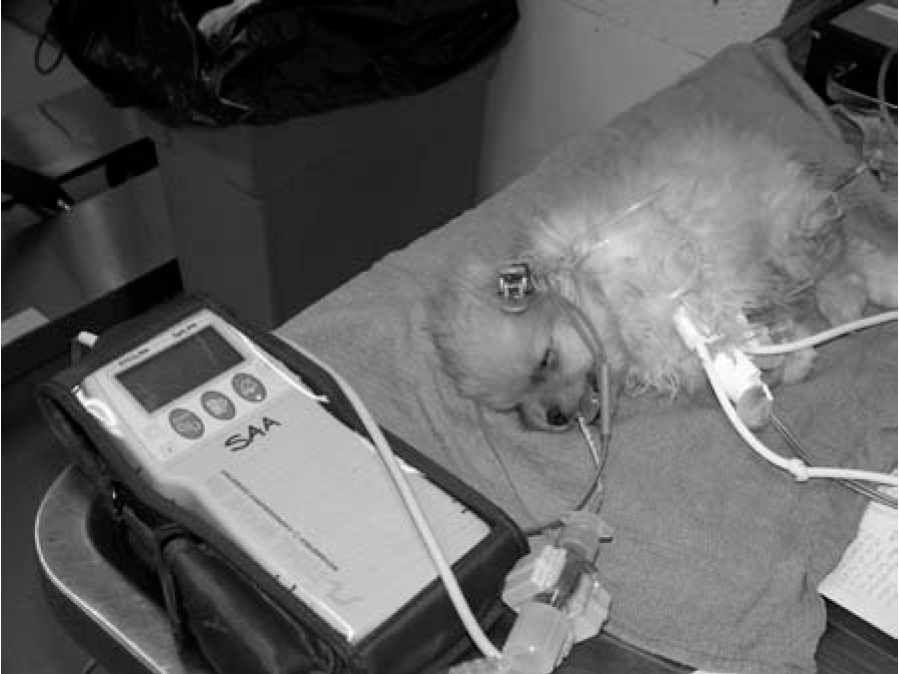normal end tidal co2 dog
It is the measurement of CO2 at the completion of exhalation and roughly correlates to the CO2 present in arterial blood. Throughout the breath cycle.

Learn More With This Respiratory Article By Melissa Marshall
Also called capnometry or capnography this noninvasive technique provides a breath-by-breath analysis and a continuous recording of ventilatory status.

. End-tidal CO 2 monitoring is a non-invasive means of estimating arterial CO 2. This non-invasive monitor can give valuable information about cardiac output perfusion and ventilation. End-tidal carbon dioxide monitoring ETCO2 has clinical uses far beyond solely determining hypo- or hyperventilation.
The CO 2 waveform is a valuable tool for detecting leaks in the anesthetic system rebreathing of CO 2. The normal values are 5 to 6 CO2 which is equivalent to 35-45 mmHg. Under most circumstances healthy pet no chest surgery end-tidal CO 2 is typically 5 10 mmHg less than arterial CO 2.
Although the normal range for CO2 should be between 35-45mmHg CO2 monitoring gives healthcare providers a lot more insight into what is going on with a patients condition. On the other hand a high CO2 reading may indicate airway narrowing. What is normal end tidal CO2.
The end-tidal level of carbon dioxide is generally less but is reflective of carbon dioxide in arterial blood and can serve as an indirect noninvasive method of assessing the adequacy ventilation. End-tidal carbon dioxide levels correlate fairly well with arterial carbon dioxide PaCO 2 in birds and mammals. Two private specialty referral hospitals.
Capnography in Veterinary Sedation. The end-tidal carbon dioxide tension PetCO2 measured after a single large tidal-volume breath 15 mlkg body weight was compared to simultaneous measurements of PaCO2 in 6 dogs with normal lungs who were receiving high-frequency jet ventilation HFJV. End-tidal carbon dioxide ETco 2 monitoring provides valuable information about CO 2 production and clearance ventilation.
Thirty-five client-owned dogs and cats in CPA in which CPR was. A low end-tidal CO2 may indicate poor perfusion hypovolemia or sepsis. Since problems with lungs are not common and gas exchange between alveoli and the blood is swift and effective.
In fact its commonly called the ventilation vital sign. Two private specialty referral hospitals. The measurement of end-tidal carbon dioxide ETCO 2 allows the continuous monitoring of the adequacy of ventilation and circulation in the anaesthetised patientIt measures inspired and expired carbon dioxide CO 2 throughout the whole respiratory cycle using infrared spectroscopyETCO 2 can be of value in the assessment of ventilation metabolism and of a.
More Than Just a Number. The P i CO 2 level should be at or very close to Zero. The P E CO 2 level should be between 35 and 45 mmHg these values are for the conscious spontaneously breathing animal and not influenced by the use of anaesthetic and analgesic medications.
To determine whether the partial pressure of end-tidal carbon dioxide PetCO 2 could predict return of spontaneous circulation ROSC in patients with cardiopulmonary arrest CPA undergoing CPR. It has been recognized that monitoring respirations in patients during sedation for out of the operating room procedures is valuable in preventing the occurrence of hypoxic episodes. Carbon dioxide during ventilation.
Normal arterial blood pressure values for dogs and cats are indicated in Table 111. Dog 35 - 45 45 - 55 55 Cat 30 - 38 35 - 45 50 Foal 2 mo. The value of monitoring respirations using capnography has migrated to veterinary anesthesia to protect lives of precious animals.
The end-tidal carbon dioxide tension PetCO2 measured after a single large tidal-volume breath 15 mlkg body weight was compared to simultaneous measurements of PaCO2 in 6 dogs with normal lungs who were receiving high-frequency jet ventilation HFJV. A more complete picture of carbon dioxide transfer can be obtained from a capnogram similar to an ECG tracing. 35-45 mmHg End-tidal CO2 EtCO2 monitoring is a noninvasive technique which measures the partial pressure or maximal concentration of carbon dioxide CO2 at the end of an exhaled breath which is expressed as a percentage of CO2 or mmHg.
There was an excellent linear correlation b. Both inspiratory Phase II and expiratory Phase 0 phases are steep and the alveolar.

Learn More With This Respiratory Article By Melissa Marshall

Learn More With This Respiratory Article By Melissa Marshall

Pdf Capnography In Dogs Semantic Scholar

Learn More With This Respiratory Article By Melissa Marshall

Learn More With This Respiratory Article By Melissa Marshall
Riding The Wave Of Capnography Understanding Etco2 Vetbloom Blog

Pdf Capnography In Dogs Semantic Scholar
Did You Know Hypercapnia Is Synonymous With Hypoventilation

Learn More With This Respiratory Article By Melissa Marshall

Learn More With This Respiratory Article By Melissa Marshall
Riding The Wave Of Capnography Understanding Etco2 Vetbloom Blog

End Tidal Carbon Dioxide Tension Pet Co 2 In Normal Individuals Over Download Table

Pdf Capnography In Dogs Semantic Scholar

